Posts Tagged ‘bush arson’
Thursday, November 10th, 2011
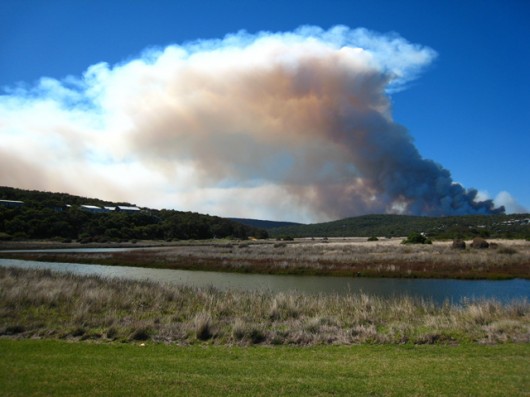 Ash Wednesday Bushfires in 1983 – approaching Anglesea on Victoria’s Great Ocean Road, Australia Ash Wednesday Bushfires in 1983 – approaching Anglesea on Victoria’s Great Ocean Road, Australia
.
This article was initially published by Tigerquoll 20090622 on CanDoBetter.net in the aftermath of the devastating Victorian bushfires that climaxed on 7th February 2009, quickly branded by the media as ‘Black Saturday‘:
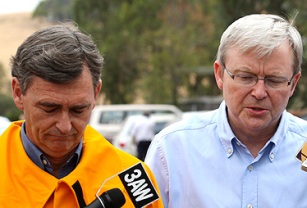
Ultimate responsibility at the time – Victorian Premier Brumby and Australian Prime Minister Rudd
(and tomorrow is Armistice Day when nearly a hundred years ago people questioned…
‘Ultimate Responsibility‘)
.
The Victorian Premier Brumby’s Royal Commission into the January-February 2009 bushfires is a mere incident review. If Victoria is to be protected from firestorms in future, it should undertake a root cause analysis, including the numerous past investigations into bushfires, with a view to achieving a cultural shift in rural fire fighting methods, resourcing and emergency management and into ecology management, housing approvals in bushfire prone areas, building design in bushfire prone areas, bush arson criminology and into serious resourcing of rural fire management.
Indeed, given the repeated history of bushfires across Australia and the repeated uncontrolled nature of many of these leading to extensive property damage, the loss of thousands of livestock, widespread ecological destruction, the human lives lost and injuries, and the massive costs incurred every year, the scope of the enquiry should be escalated to a national level.
But the Victorian Commission’s terms of reference focuses on the immediate causes and circumstances of the 2009 Victorian Bushfires. It focuses on the immediate management, response and recovery. This is a start, but the real start occurred in 1939 with the shock of Black Friday. It lead to the Stretton Enquiry, but many large and damaging firestorms have occurred since – so the Stretton Enquiry showed that lessons were either ignored or the application of those lessons were ineffective. The Esplin Inquiry of 2003 identified striking parallels between 1939 and 2002-3 bushfires. Now we have the 2009 Bushfires, but each investigation is disconnected from the previous one, almost as if to intentionally ignore history and any prior lessons learnt. Interstate and overseas, many major bushfires and their subsequent investigations have amassed research, insight and lessons. Why limit the investigation to one event?
Incident investigation will uncover causes and flaws and will likely make specific recommendations in the hope of preventing similar incidents. But root cause analysis goes beyond identifying the symptoms of a problem. But the Commission has not started with identifying the problem.
- Let’s premise that at the core is the problem of preventing ignitions becoming firestorms.
- What are the causes of uncontrolled ignitions in the bush.
- Where are they typically lit?
- How are ignitions detected by fire authorities?
- What is the time lapse between ignition and detection?
- What is the time lapse between detection and response and eventual suppression?
- Which causes and interventions would mitigate the risk of these ignitions developing into uncontrollable firestorms?
- Are the ignition detection tools adequate?
- Are the communications tools adequate?
- Do we have the right tools and trained personnel in the right places to effectively respond?
- Is the entire detection, response and suppression system sufficiently integrated to deal with multiple ignitions in extreme conditions across the State at the same time? How would this be achieved?
- What budget would be required to have such resources and technology in place to achieve this standard?
- Is the problem indeed too big for Victoria by itself to adequately deal with and so is the problem in fact a national one?
- How would a satisfactory solution be achieved without causing other problems like ecological damage and local wildlife extinctions?
.
Then implement the recommendations and scientifically monitor their effectiveness.
However, the Commission is looking at what caused the specific ignitions, what damage the specific bushfires caused and specific responses. It will conclude what specifically should have been done in these specific incidents. It will lead to a blame game that will solve nothing. Subsequent ignitions if not predicted, detected, responded to and suppressed to prevent firestorms, will likely have different circumstances in different locations. So how will the problem have been solved by this royal commission?
.
.
What about the affected people up in the Bush?
.
Horror, shock, helplessness, anger, loss – loved ones, family, next door neighbours, familiar faces gone. Then there’s financial loss, bank issues – sympathy first but then demands, threats and ambivalence. This is whole livelihoods. It is devastation. The initial trauma (community and personal), plus the ongoing trauma (community and personal).
Governments do the obligatory media spin, but as months pass they move on to other priorities. But the people don’t – whether they end up staying or going, the trauma stays.
This was absolutely catastrophic! Catastrophic! No-one can prepare or recover as easy as Government claims. What is ‘moving on’?
This is War Reparations league! A war hit here and ordinary people were simply living their ordinary lives in the bush. Another token bushfire enquiry without bushfire reform is repugnant, ignorant and callous. How will the Victorian Royal Commission prevent bushfire history repeating itself?
If our society could cope before, we may accept fate. But knowing the extreme risk in February 2009 and now, fate is no excuse. It is wrong for government to pursue bushfire management nonchalant business-as-usual in Victoria… in Australia.
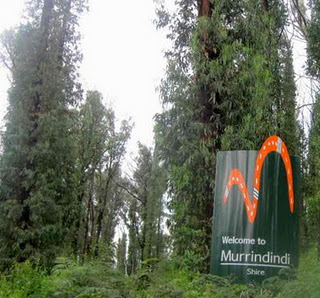
.
.
Footnote
.
My uncle and aunt lost their family home down at Angelsea during the 1983 Ash Wednesday bushfires. They weren’t insured. Though they escaped with their lives, they lost everything else. Thereon they were never really quite the same. They became refugees in their home community.
 Anglesea Dreaming – a recollection of one’s youth and holidays Anglesea Dreaming – a recollection of one’s youth and holidays
.
.
Tuesday, November 8th, 2011
This article was initially published by Tigerquoll 20090620 on CanDoBetter.net in the aftermath of the devastating Victorian bushfires that climaxed on 7th February 2009, quickly branded by the media as ‘Black Saturday‘:
.
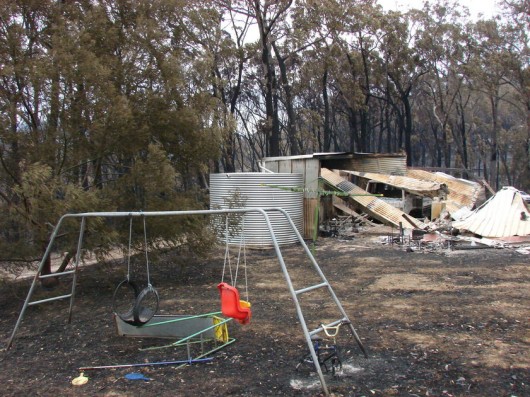 Children’s play equipment sits in front of a house destroyed by bushfire in Chum Creek
North Healesville, Victoria, Australia
[Photo: ABC] Children’s play equipment sits in front of a house destroyed by bushfire in Chum Creek
North Healesville, Victoria, Australia
[Photo: ABC]
.
Pursuing the ‘bunker solution‘ is a dead end that no government will underwrite – think of the risk of failure!
What has been avoided in this Victorian bushfire debate are the fire fighting statistics. Where are the fire fighting operational metrics showing the time between ignition and detection and response and suppression?
Is anyone considering the fundamental task of effective bush fire fighting as a key cause of this disaster? The operational metrics, if indeed collated, would be alarming to the general public. The unprecedented extreme risk of uncontrollable wildfires was known to fire fighting operations management, yet no extraordinary resources were deployed in advance. Hours, not minutes, lapsed between ignitions, detection and responses. As a consequence, suppressions via a tired old truck-centric response methodology was demonstrably grossly inadequate. CFA responses were absolute failures in the tactical response to the February 2009 Victorian Bushfires. The whole show descended into an incompetent stuff up which resorted to the worst case scenario – ‘every man for himself’.
Only vigilante fire response had a chance of working. Acceptable may be in 1909, but not in a sophisticated 2009 supported by millions in annual funding and research. The response at strategic management level was ‘Keystone Kops‘. The field response was like a tragic Gallipoli – a strategic blunder with good men sent in with too little, too late.
The Marysville community like others didn’t deserve official response approach of ‘too hard basket’ and abandonment. The result was incineration entrapment.
This is the lesson of the incompetence of the CFA, DSE and Emergency Management Australia. An ignition started in the bush is not an uncontrollable tsunami. But in conditions like that in January 2009 in Victoria, an ignition and more so multiple ignitions become equivalent to a tsunami if conditions, delay and inadequate resources are a combined factors.
The systemic failure to deal with ‘before-the-fact’ (ignition) causes is just as vital in being effective at bush fire fighting. I am not talking about slashing and burning the Aussie bush like an ‘Agent Orange’ sortie over Vietnam to eliminate all threat and wildlife habitat. I am talking about grossly negligent housing approvals in extreme bushfire areas, about grossly negligent property owners building houses out of flammable materials and doing squat about bushfire preparedness, about governments at all levels that fail to prepare bushfire prone populations and that fail to effectively communicate emergency drills to protect their lives, and that fail to provide sufficient resources to stop bushfires killing people.
Police are only this week interviewing residents around Bendigo to try to identify the suspected arsonist of that fire – five months later as a one-off investigation. Why did Brumby wait 5 months to investigate? I wager the arsonist involved could have been detected well in advance had a co-ordinated permanent bush arson squad been established long ago complete with specialist criminologists, psychologists, experienced bush fire investigators, criminal investigators, etc and enough resources to allow them to do their job.
I have no time for political band-aids or government responses that invariably involve millions that do not address the root causes of the problem. The bush itself, as habitat to millions of Australian animals must first be respected as the mutual innocent victim. Bushphobic responses by fanatics calling for scorched earth blanket responses will only fuel greater ecological catastrophe.
.
.
Further Reading:
.
[1] ‘Bushfire bunkers may be death traps’
.
[Source: ABC Radio ‘AM’ Programme adapted by Zoie Jones, 20090511, ^http://www.abc.net.au/news/2009-03-02/bushfire-bunkers-may-be-death-traps/1605846]
.
‘With firefighters on high alert in Victoria, some people in bushfire risk zones have decided to install fire bunkers on their properties. But there are no regulations controlling the structures and there are concerns some of the fire shelters could be death traps.
Garrie Ferguson, who lives in the bushfire-prone Adelaide Hills, has started selling reinforced concrete water tanks as bushfire bunkers.
“If at the end of your street you only have one way in, one way out, you either run the fire in your car and risk getting killed, you either go back to your house and risk burning in there,” he said. “Or risk the chance of hopping in underground to something that’s very well protected and try and outride it in there.”
For under $3,000 Mr Ferguson can install a concrete tank that fits six people and comes with metres of underground piping that holds reserve air. He has sold 14 bunkers in the past two weeks.
“I do actually have a member of the metropolitan fire service that has bought one as well,” he said.
But Mr Ferguson cannot guarantee that people will be safe. “I can’t guarantee anything at all. Somebody might put 12 people in it, use the oxygen supply and die,” he said.
Another option that some people are turning to, is to install a shipping container into the side of a hill.
Robert Caulfield from the Australian Institute of Architects warns against the temperatures that can be generated inside the containers and the possibility of running out of oxygen.
“It’s quite possible we could end up with fireproof shelters with people absolutely cooked inside it or get suffocated,” he said. Mr Caulfield says during the bushfires three weeks ago shelters with steel roofs and similar features became glowing hot.
“It really needs a rigorous test on these sorts of things because once you get something generating that sort of heat it will also actually set up convection currents inside it, it can start fires inside the unit and so forth,” he said.
The institute is now calling for an urgent review and testing of the products being sold as fire bunkers.’
.
.
[2] ‘Bushfire Bunkers Report’
.
by the Victorian Bushfire Royal Commission in its Final Report – Section 6.10 ‘Bushfire Bunkers’, p. 190^http://www.royalcommission.vic.gov.au/finaldocuments/volume-2/PF/VBRC_Vol2_Chapter06_PF.pdf]
.
‘In its second interim report the Commission expressed its concern about the lack of regulation for bunkers, the risks of misplaced reliance on bunkers, the demand for bunkers, and the widespread availability of bunker products. It tackled the clear and pressing need for a minimum standard to regulate the design, siting and construction of bunkers by recommending that the Australian Building Codes Board (ABCB) develop a standard as a matter of priority.
The Commission also made recommendations designed to ensure that, in Victoria and nationally, bunkers are regulated under building legislation and the standard developed by the ABCB is referenced as the minimum standard for construction of bunkers.
On 30 April 2010 the ABCB released a performance standard for private bushfire shelters; the standard is available free on the ABCB website. The ABCB advised the Commission that the 2011 edition of the Building Code of Australia will include bunkers and will reference the standard. In the meantime, the Commonwealth and the ABCB will continue to encourage all jurisdictions to adopt the bunker standard by means of interim regulations. On 28 May 2010 the Victorian Government adopted the standard through an amendment to the Building Regulations. The Commission commends this swift action to finalise and adopt the standard.’
.
.
[3] ‘Fire Bunkers: Interim Regulations Released’
by Fire Protection Association of Australia, ^http://a.cdn.fpaa.com.au/docs/Fire%20Bunkers.pdf [Read Document]
.
.
[4] ‘Bushfires Royal Commission makes early recommendations for fire bunker standards’
.
by Geraldine Mitchell, 20090921, ^http://www.heraldsun.com.au/news/special-reports/early-guidelines-for-bushfire-bunkers/comments-fn4chuwg-1225777637531]
.
‘The bushfires Royal Commission will make early recommendations for building standards as Victorians rush to install bunkers and rebuild their homes in high- risk areas. Commission chairman Bernard Teague has just announced the commission will not wait until the release of its final report next year to make the recommendations.
Commissioner Teague said evidence in relation to building standards indicated changes needed to be made before the next bushfire season. He said recommendations would focus on the regulation of bushfire bunkers, changes to the new building standard and a revision of the Standards Australia handbook. Further hearings will be held on Friday, October 30 and recommendations are expected to be released before the end of the year. Last month the commission heard bushfire survivors rebuilding homes in ravaged areas were making risky decisions as officials wrangled over the best building standards.’
.
Comment by ‘Les’ 20090926:
‘As a base standard the existing bunkers or dug outs at Surrey Rd, Powelltown, or the intersection of Warburton to Woodspoint Rd and Rd 7 Upper Yarra, or on top of Mount Ritchie off Rd 10 in the O’Shannasy, should be looked at (being) maintained! As to the base level add 10% to February 7th, and budget to maintain them, problems occur when Government Agencies start cutting maintenance costs because nothing has eventuated for 5 years.’
.
.
[5] ^Fire bunkers could have helped in the Victorian fires
.
[6] ^How misconceptions about bushfire bunkers may cost lives
.
[7] Wildfire Safety Bunkers, ^ http://www.wildfiresafetybunkers.com.au/
.
[8] ‘Death Trap or LifeSaver? ‘, ^http://www.firesheltersaustralia.com.au/media/Bushfire%20Shelters.pdf [Read Document]
.
[9] ‘ Bushfire Bunkers – A Summary of Products and Concepts‘, by the Royal Commission into the 2009 Victorian Bushfires, [ Read Report]
.
[10] ‘ Bushfire survivor shares tale of escape‘, transcript of interview by ABC 7:30 Report, 20090212, ^ http://www.abc.net.au/7.30/content/2008/s2490128.htm [ See video]
..
.
https://www.habitatadvocate.com.au/wp-content/uploads/2011/11/Fire-Bunkers-Interim-Regulations-Released-FPAA-20091204.pdf
Saturday, July 9th, 2011
Originally posted February 23rd, 2009 by Tigerquoll on CanDoBetter.net
.
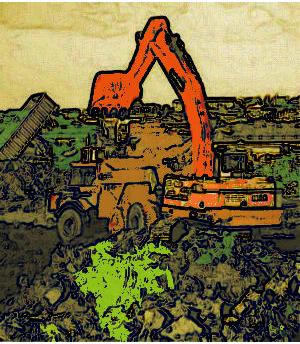
In Victoria in 1992, some bureaucrat got the idea of changing the name (and focus) of the Department of Conservation and Environment to a Department of Conservation and Natural Resources, then in 1996 to a Department of Natural Resources and Environment, then in 2003 a split to (1) a Victorian Department of Primary Industries and (2) a Department of Sustainability and Environment.
[Source: http://www.austehc.unimelb.edu.au/asaw/biogs/A002037b.htm – Note: this link has subsequently been altered by the University of Melbourne to protect its petty government funding and disclosing its forestry bias]
.
Currently this government department is known by an obscure acronym: ‘DSE‘. But those out in the ‘tree face’ genuinely caring for old growth forests of Victoria, discard this acronym to mean either…’Don’t Support Environment‘ or simply the ‘Department of Sparks and Embers‘. The reason in empirical. The DSE has a reputation for Forestry Logging bias – facilitating old growth logging, habitat deforestation and related bush arson.
Meanwhile, across the border in NSW, in 2007, the Department of Environment and Conservation (DEC) was changed to the Department of Environment and Climate Change (DECC) so as to make it look like the NSW Labor Government publicly cared about climate change by delegating a name change.
.
While pandering to ‘climate change’ populism, the fundamental concept of ‘conservation’ has been dismissed by government.
.
All the DEC business cards and logos were changed to DECC at what impact on climate change? At what cost this extra ‘C‘? The cost has been to remove the Conservation imperative!
Rather than forming a dedicated research and response organisation to focus on climate change, the conservation was dropped from the existing department. Cynically, including ‘climate change’ as a name of one of its departments, government must feel cosy sending a message it is addressing climate change. For a while the department was headed up by The NSW Minister for Climate Change, Environment and Water – a bucket of outdoor type activities that sounded good together.
Across the border in South Australia, they have the Department for the Environment and Heritage (DEH), which sounds borrowed from the federal Department of the Environment, Water, Heritage and the Arts (another collective bucket). It is hard to see how with so many diverse portfolios, a minister can dedicate any leadership to making genuine improvements to what’s left of Australia’s intact natural environment and its desperate need for conservation.
With all the money spent on names changing, the tens of thousands could have gone into on-ground conservation activities like fox control programmes.
Tags: biodiversity, bush arson, CFA, climate change, commercialisation, commodification, conservation, Country Fire Authority, Department of Sparks and Embers, Don't Support Environment, forestry bias, greenwashing, national parks, national parks exploitation, University of Melbourne, VicForests
Posted in Threats from Greenwashing | No Comments »
Add this post to Del.icio.us - Digg
Thursday, May 26th, 2011
[The following article has been borrowed from a section of a previous article on this website: ‘Blue Mountains copping government-arson‘, since this important message has ramifications beyond the natural areas of the Blue Mountains].
.
– – – – – –
.
.
From the frying pan…
.
When bushfire management can contrive no other excuse for setting fire to native vegetation, like when native vegetation is many miles away from human settlement and so poses no direct threat; out comes a concocted academic theory called: ‘ecological burning ‘. Over how many beers?
When those in whom our community trusts to put out bushfires, decide instead to start setting fires to bushland, and descend instantly into a betrayal of that that trust, to whom can our community entrust to put out bushfires? Government has been proven to suck.
What has happened to ecological values of the bush and the sense of urgency to put out bushfires that threaten both it and us?

.
‘Ecological Burn’ Theory
.
- The ‘ecological burn’ theory starts with the premise that because humans have observed that the Australian bush ‘grows back’ (eventually) after a bushfire, it may be concluded that the Australian bush can tolerate bushfires. This hypothesis relies on evidence that selected species of Australian germinate after smoke and fire and the example of epicormic growth of many Eucalypts after fire.
- The deductive fallacy of this theory is that all the Australian bush is bushfire tolerant.
- This deduction is then extended by unsupported assumption that since the Australian bush is bushfire-tolerant, bushfire must be an integral natural process to which the Australian bush has become adapted to bushfire.
- The assumption is then extrapolated to assert that bushfire is indeed beneficial to the Australian bush.
- The assumption is then stretched even further to conclude that without bushfire the Australian bush will be adversely affected.
- The ecological burn theory then prescribes that by burning the Australian bush, whether by natural or unnatural means, the biodiversity of the Australian bush will be improved.
- The deductive fallacy goes further, to suit the motives of the fire-lighters. The outrageous generalisation is made that all the Australian bush must be burnt at some stage for its own ecological benefit.
.
So the ‘Ecological Burn’ mantra has become:
‘Go forth and burn wilderness. It’ll grow back. It’ll do it good.‘
.
.
Habitat ‘fuel’ gone…so it wont burn now!
.
The perverted irrational logic that Australia’s native vegetation has adapted to recover from bushfire is akin to claiming the human body is adapted to recover from injury such as burns. A wound may heal but no-one seeks to be injured in the first place. And not all wounds heal. A third degree burn to more than 50% of a human body is almost a certain death sentence. What percentage of a wild animal’s body can be burnt and the animal still survive? That’s a perverted question for the fire-lighters.
Broadscale hazard reduction is not mosaic patch-work fire. It is not creating a small scale asset protection zone around the immediate boundary of a human settlement. It is wholesale bush arson that is driving local extinctions. Ever wonder why when bush walking through the Australian bush so few native animals are seen these days? Their natural populations have been decimated through two centuries of human harm – mainly poaching, introduced predation and habitat destruction including by human-caused bushfires and human-abandoned bushfires.
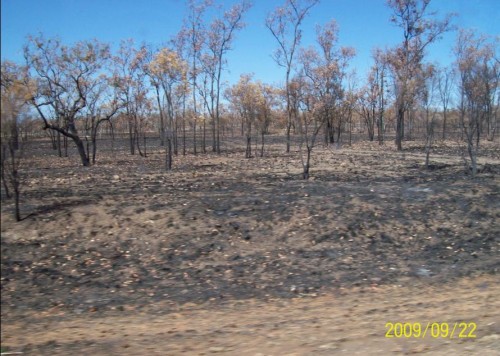 Broadscale incineration of native bushland across northern Queensland
by the Rural Fire Service Queensland.
Habitat ‘fuel’ gone ~ so it won’t burn now! Broadscale incineration of native bushland across northern Queensland
by the Rural Fire Service Queensland.
Habitat ‘fuel’ gone ~ so it won’t burn now!
©Photo by Ann Jurrjens, 20090922.
(click photo to enlarge, then click again to enlarge again).
..
.
.
.
Likely Origins of the ‘Ecological Burn’ myth
.
The concept of the ‘ecological burn’ sounds like the academic contrivance that it is. It is an outpouring from a handful of forestry academics who have successfully sold their consulting services to government under a similarly contrived expertise of being ‘fire ecologists‘ or ‘fire scientists‘. Well, at least ‘garbologists‘ work for a living.
After a major bushfire, an affected and sometimes devastated public cries for answers and the media cash in with their newspaper-selling witch hunt. The responsible government politicians and department directors of the bushfire management deflect accountability away from themselves by instigating a tried and tested ‘bushfire enquiry‘. Those enquiries seek expert evidence and so the ‘fire ecologists’ come out of the woodwork, professing expert insight into the reasons for uncontrolled bushfire and contriving theories for better bushfire management. They invariably proclaim ‘I told you so!
With the frequency of uncontrolled bushfires year after year, there have been so many enquiries across Australia, sufficient to fill bookshelves; each one wastefully gathering dust. Yet with the almost annual disaster recurrence somewhere across Australia, the relevance of ‘fire ecologists’ has morphed fire ecology into an almost full-time occupation – generally on the payroll of the government agencies seeking to justify excuses why they didn’t put out the bushfires in the first place.
The origins of ‘fire ecology’ and to the ‘ecological burn’ theory may be at least traced back to Victoria, an Australian state with perhaps the worst record of bushfire management in the country. During 1999 a series of ‘Fire Ecology Workshops’ were held at Country Fire Authority stations across the state. In that year the ‘Interim Guidelines an Procedures for Ecological Burning‘ was published by Victorian Government’s departments: Natural Resources and Environment and Parks Victoria. References to this and related documents may be found by following the links under References below.
It must have been like an evangelistic mission by these new ‘fire ecologists’, leveraging the common human terror of fire into a way of dealing with that fear once and for all. The final solution would go beyond ‘back-burning‘, beyond the ‘controlled burn‘, beyond ‘hazard reduction‘. It means burning the bush before it burns; but this time on a massive scale, taking the fire-fight to wilderness.
The ‘ecological burn’ theory has gone further. It has brainwashed fire-fighters and natural land managers into believing that burning the bush is indeed good for the bush, good for biodiversity. This is a paradigm cultural shift to a sense of ecological righteousness – by burning the bush you are doing biodiversity a favour. And the fire scientists’ proof of their theory is down to the epicormic growth and the selected native plant species shown to be fire-tolerant, and with that fire-tolerance must be ecologically sustainability. As soon as some green regrowth occurs, they are out taking photos to support and promulgate their theory. ‘Look it grows back’ they claim. Except that these same species that recover from fire have ended up dominating the natural landscape.
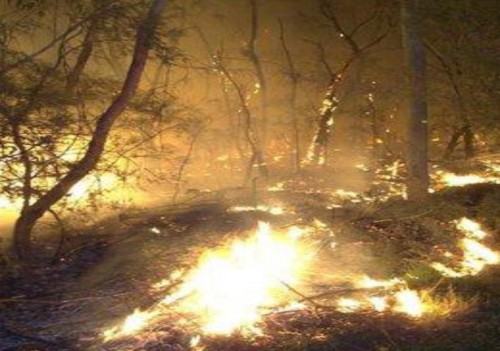 Fire-Lighters’ bliss
.
Fire-Lighters’ bliss
.
‘A Firelighters’ Bliss‘:.
‘a state of profound satisfaction in lighting a bushfire, the equivalent happiness and joy in doing so, a constant pyromaniac state of mind, undisturbed by gain or loss, so long as the lit bush burns fiercely’. i.e. the aroused state of ignition frenzy by either a closet, suspected or convicted bush-arsonist!
.
So forget Aboriginal traditional mosaic burning theory – so passé and so ineffective (below napalm baseline). So the message is officially clear, if you want to avert calamities like Black Friday, Black Saturday and the demonising of the rest of the days of the week, burn the bush in swathes, lest it burn you first. The theory is ecological satanism. It is up there with the Y2K bug. It has led a wholesale conversion of bush fire-fighters into fire-lighters on a grand scale akin to scientology’s hold on young people in the 1970s. It has culminated in an escalation of prescribed burning to an extent well outside any reasonable justification for protecting human life and property from the risk of bushfire. The ‘ecological burning’ extremists evangelise is that burning should be ‘strategic’ and for strategic zones spanning thousands of hectares of wilderness to be targeted for burning. What they avoid problem-solving is why they don’t put out the ignitions in the first place.
‘Ecological fire’ is a myth that has festered into the greatest ‘eco-crime’ in Australia’s history, second only to 19th and 20th Century widespread clear-felling. The ‘ecological fire’ myth is the most devastating driver of man-made extinctions plaguing Australia in the 21st Century.
.
A Test for ‘Fire Ecologists’:
.
Name one case study in Australia published in a peer-recognised scientific journal… in which independent wildlife ecologists have conducted proper before-and-after field tests of fauna-and-flora-biodiversity…where natural (pre-1788) biodiversity has been found to flourish… as a provable result of a broadscale ecological burn!
.
In August 2000, possibly the country’s chief druid of bushphobia, Kevin Tolhurst, produced a report seeking to justify the previous year’s setting fire to most of the Mount Cole State Forest, situated over 20km east of the town of Ararat in Victoria’s central west district. At the time, Tolhurst was part of the School of Forestry at the University of Melbourne.
Part of the report included, Appendix 3: Guidelines for the Ecological Burning in foothill forests of Victoria, in which an overview of the Mt Cole Case Study was provided. Notably, this report is provided not found on the University of Melbourne website, but that of the Department of Primary Industries of Victoria website. Clearly the ‘ecological burning’ concept stems not from preferred prestigious academic credentials, but moreso from politically motivated Primary Industries exploitive expedience.
The primary vegetation types targeted were ‘grassy dry forest’ and ‘herb-rich foothill forest’ which had not been burnt for an estimated 35 years, according the Natural Resources and Environment (Vic) corporate GIS database.
.
Tolhurst’s report states:
“Mt Cole State Forest was selected on the basis of having extensive areas of long-unburnt vegetation. A couple of areas within the forest had already been earmarked for prescribed burning from a fire-protection point of view. Mt Cole is an extensive area of easily defined forest with a wide range (of) vegetation types, ages, uses and values. The landscape management unit used in this example is about 32,000 ha in extent if which about half is forested and the other cleared for agriculture. There is little functional connection between this forest area and any other forest.”
“..The broad ecological management objective for Mt Cole State Forest, as part of the Midlands Forest Management Area is to : ‘Ensure that indigenous flora and fauna and communities survive and flourish throughout the Midlands Forest Management Area.”
…Flora and Fauna Inventory:
“Species found in study area as a result of a ramble survey of approximately 20 minutes at each location.”
.
Clearly, the motive underlying the so-called ‘ecological burning’ was the irrational fire-lighting cult fear of ‘long-unburnt vegetation’ daring to remain unburnt or so long – a symptom of bushphobia. ‘From a fire-protection point of view’ is the real motive and so it was convenient to just set fire to the lot. So some 32,000 hectares of a surviving island of native habitat was torched. After decades of agricultural land clearing Mt Cole State Forest had indeed been sadly reduced to having “little functional connection between this forest area and any other forest.” So why not just wipe the rest off the face the Earth? It probably stood out like a sore thumb coloured red for ‘high risk on ‘strategic’ CFA maps anyway.
And the blanket ‘ecological burn’ would see to it to ‘ensure that indigenous flora and fauna and communities survive and flourish throughout the Midlands Forest Management Area.”
Perhaps, post-burn, a similar 20 minute flora and fauna inventory was conducted in the CFA truck with a few tinnies, playing… ‘first-to-spot-the-first-bloated-blackened-wombat‘.
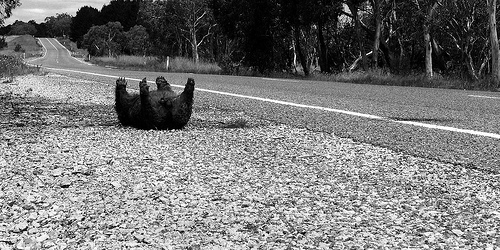 Dead Wombat Dead Wombat
.
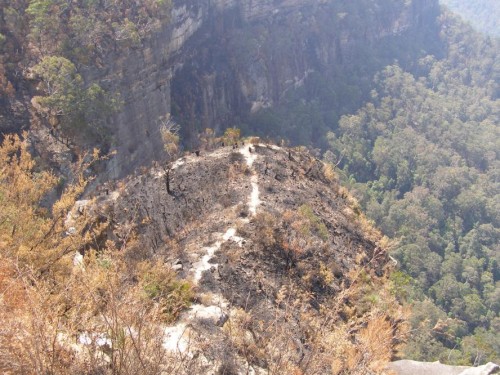
Defacto Hazard Reduction on the Grose Valley Escarpment, 2006
The fragile yet complex and vital soil biota of the escarpment built up over perhaps centuries,
gone after subsequent rain.
Habitat ‘fuel’ gone ~ so it won’t burn now!
(click photo, then click again for zoom details)
[Photo is ours, so free in public domain]
.
.
.
.
References
.
[1] ‘ Management of Fire for the Conservation of Biodiversity‘ – Workshop Proceedings, May 1999, Fire Ecology Working Group (Gordon Friend, Michael Leonard, Andrew MacLean, Ingrid Sieler), Natural Resources and Environment, Parks Victoria, ^ http://www.dpi.vic.gov.au/CA256F310024B628/0/0F55F0F75BFB3FCECA257231000D9F4D/$File/Mgt+of+fire+for+Cons+and+Biodiv.pdf.
.
[2] ‘Appendix 3: Guidelines for the Ecological Burning in foothill forests of Victoria’, Department of Primary Industry (Victoria) website, ^ http://www.dpi.vic.gov.au/CA256F310024B628/0/CC122443185E3E38CA257231001076A7/$File/MgtofCons_MtCole_CaseStudy_p21-27.pdf.
.
* Above references accessed 20110526.
.
.
– end of article –n
Tags: bush arson, bushfire tolerant, dead wombat, defacto hazard reduction, eco-crime, ecological burn, ecological burning, epicormic growth, fire ecologist, fire scientist, fire-lighter bliss, government bush-arson, hazard reduction, prescribed burning
Posted in 36 Tests of Harm!, Threats from Bushfire | 1 Comment »
Add this post to Del.icio.us - Digg
|
|
 Ash Wednesday Bushfires in 1983 – approaching Anglesea on Victoria’s Great Ocean Road, Australia
Ash Wednesday Bushfires in 1983 – approaching Anglesea on Victoria’s Great Ocean Road, Australia
 Anglesea Dreaming – a recollection of one’s youth and holidays
Anglesea Dreaming – a recollection of one’s youth and holidays


















